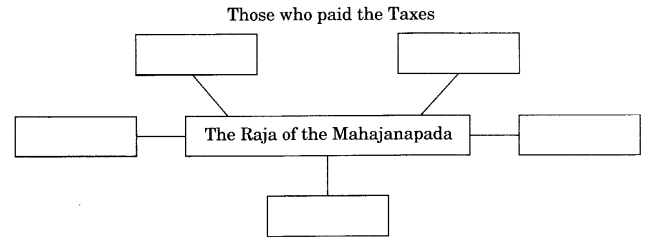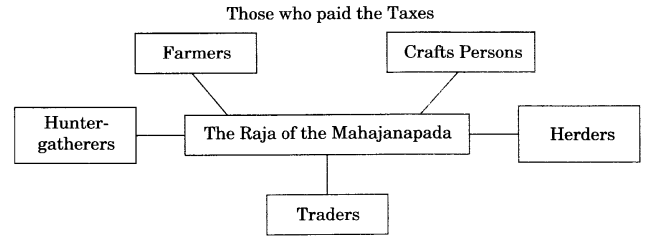NCERT Solutions for Class-6 History Chapter-6 Kingdoms, Kings and an Early Republic
NCERT TEXTBOOK EXERCISES
1. Rajas who let the Ashvamedha horse pass through their lands were invited to the sacrifice.
2. The charioteer sprinkled sacred water on the king.
3. Archaeologists have found palaces in the settlements of the janapadas.
4. Pots to store grain were made out of Painted Grey Ware.
5. Many cities in Mahajanapadas were fortified.
Answer:
1. True
2. False
3. False
4. False
5. True.
Question 2. Fill in the chart given below with the terms:
hunter-gatherers, farmers, traders, craftspersons, herders.
Answer:
Question 3. Who were the groups who could not participate in the assemblies of the ganasl
Answer: Women, slaves, and Kammakaras could not participate in these assemblies.
Question 4. Why did the rajas of mahajanapadas build forts?
Answer: Forts were built by the rajas of the Mahajanapadas because people were afraid of attacks from other kings and needed protection. It is also likely that some rulers wanted to show how rich and powerful they were by building large, tall, and impressive walls around their cities.
Question 5. In what ways are present-day elections different from the ways in which rulers were chosen in janapadas?
Answer: Choosing rulers in ‘janapadas’ - Men were chosen ‘rajas’ by performing big sacrifices. The ‘Ashvamedha’ (horse sacrifice) was one such ritual that was used to identify a ‘raja’. The ‘raja’ chosen by this sacrifice was considered very powerful. Electing rulers today—Today, we have a democratic system of government. Each citizen has a right to vote and the government is decided by-elections in which each citizen casts his vote.
Answer: For self-study (with the help of your teacher).
Hints for Students:
1. Find the name and location of your state (i.e., the state or UT to which you belong). Write the name of your region.
2. Look there (i.e., in the map) any Janapada site in your State or Union Territory (UT).
3. If yes, name that (old) Janapada or Janapadas.
4. If not, look around all directions of your state (east, west, north, south) and write the names of Janapadas.
Question 7. Find out whether any of the groups mentioned in answer 2 pay taxes today.
Answer: The groups mentioned are hunters and gathers ers, farmers, traders, craftspersons herders. The farmers, traders, and craftspersons pay taxes today.
Question 8. Find out whether the groups mentioned in answer 3 have voting rights at present.
Answer: Today, voting rights are not decided by gender or profession. Women, ‘khmmakaras’ and ‘dasas’—all are entitled to vote today.

0 comment
Post a Comment